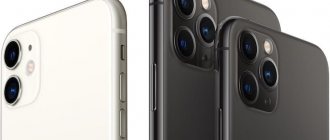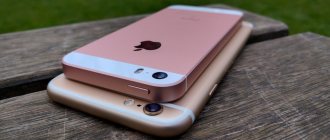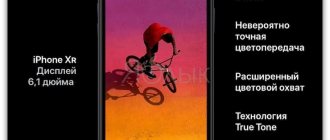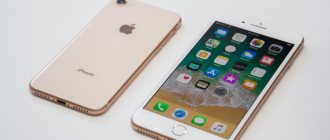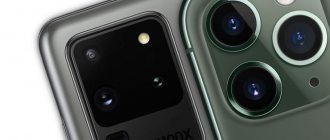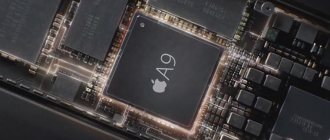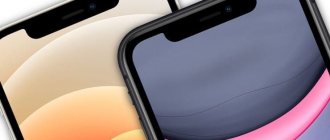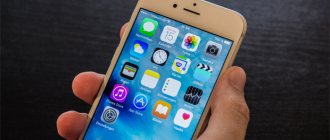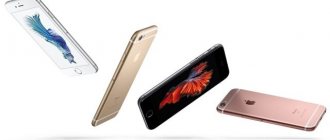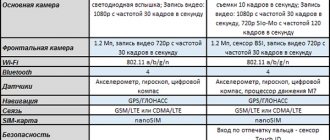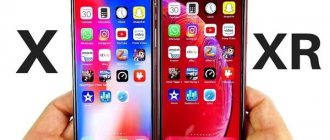Operating systems iOS
05.08.20193288
or you can download music from your hard drive to your device without understanding the intricacies of Apple technology; Moreover, without knowing the model of your phone. However, the user sometimes needs to determine what kind of iPhone he has in his hands - for example, if there is a need to ask a friend for remote consultation or contact a service center. Let’s try to figure out how to find out your iPhone model.
View on iPhone case
If there is no box left, the iPhone owner should pay attention to the back cover of his device - here, beautifully engraved, there will definitely be a model number. You can correlate it with Apple’s “human” line using the table below.
| Number | Model, year of manufacture |
| A1203 | iPhone (2007) |
| A1241 | iPhone 3G (2008, 2009) |
| A1303 | iPhone 3GS (2009) |
| A1324 | iPhone 3G (2008, 2009) |
| A1325 | iPhone 3GS (2009) |
| A1332 | iPhone 4 (2010, 2011) |
| A1349 | iPhone 4 (2010, 2011) |
| A1387 | iPhone 4s (2011) |
| A1428 | iPhone 5 (2012) |
| A1429 | iPhone 5 (2012) |
| A1431 | iPhone 4s (2011) |
| A1442 | iPhone 5 (2012) |
| A1453 | iPhone 5s (2013) |
| A1456 | iPhone 5c (2013) |
| A1457 | iPhone 5s (2013) |
| A1507 | iPhone 5c (2013) |
| A1516 | iPhone 5c (2013) |
| A1518 | iPhone 5s (2013) |
| A1522 | iPhone 6 Plus (2014) |
| A1524 | iPhone 6 Plus (2014) |
| A1528 | iPhone 5s (2013) |
| A1529 | iPhone 5c (2013) |
| A1530 | iPhone 5s (2013) |
| A1532 | iPhone 5c (2013) |
| A1533 | iPhone 5s (2013) |
| A1549 | iPhone 6 (2014) |
| A1586 | iPhone 6 (2014) |
| A1589 | iPhone 6 (2014) |
| A1593 | iPhone 6 Plus (2014) |
| A1633 | iPhone 6s (2015) |
| A1634 | iPhone 6s Plus (2015) |
| A1660 | iPhone 7 (2016) |
| A1661 | iPhone 7 Plus (2016) |
| A1662 | iPhone SE (2016) |
| A1687 | iPhone 6s Plus (2015) |
| A1688 | iPhone 6s (2015) |
| A1699 | iPhone 6s Plus (2015) |
| A1700 | iPhone 6s (2015) |
| A1723 | iPhone SE (2016) |
| A1724 | iPhone SE (2016) |
| A1778 | iPhone 7 (2016) |
| A1779 | iPhone 7 (2016) |
| A1784 | iPhone 7 Plus (2016) |
| A1785 | iPhone 7 Plus (2016) |
| A1863 | iPhone 8 (2017) |
| A1864 | iPhone 8 Plus (2017) |
| A1865 | iPhone X (2017) |
| A1897 | iPhone 8 Plus (2017) |
| A1898 | iPhone 8 Plus (2017) |
| A1901 | iPhone X (2017) |
| A1902 | iPhone X (2017) |
| A1905 | iPhone 8 (2017) |
| A1906 | iPhone 8 (2017) |
| A1920 | iPhone XS (2018) |
| A1921 | iPhone XS Max (2018) |
| A1984 | iPhone XR (2018) |
| A2097 | iPhone XS (2018) |
| A2098 | iPhone XS (2018) |
| A2100 | iPhone XS (2018) |
| A2101 | iPhone XS Max (2018) |
| A2102 | iPhone XS Max (2018) |
| A2104 | iPhone XS Max (2018) |
| A2105 | iPhone XR (2018) |
| A2106 | iPhone XR (2018) |
| A2108 | iPhone XR (2018) |
Important: the table shows serial numbers for models manufactured in both the USA and China, as well as in Japan; Using the nomenclature developed by Apple is much more convenient than trying to guess a product based on external features such as colors and the location of physical buttons.
Testing Apple iPhone 4S
We evaluate the intelligent assistant Siri, performance and updated camera Last Thursday, October 13, sales of the new iPhone 4S began. As always, with the already familiar attributes in the form of queues in front of Apple stores and TV reports about the first lucky ones who became the owners of the coveted “Apple” smartphone. On October 10, Apple reported that the number of pre-orders for the iPhone 4S in the first day exceeded a million (for the iPhone 4 this figure was 600 thousand). And this became clear evidence that consumer loyalty towards Apple is such that the public is even ready to forgive the postponement of the expected announcement of the iPhone 5 and buy an improved version of last year’s new product instead. But how much
improved? Today we have the opportunity to understand this in detail.
First, let's look at the technical specifications. You can see a detailed list of them here, but in the article we will present only the most important characteristics, as well as what distinguishes the iPhone 4S from the iPhone 4.
| iPhone 4 | iPhone 4S | |
| Screen (size in inches, matrix type) / resolution, pixels | 3.5″, IPS / 960×640 | 3.5″, IPS / 960×640 |
| System on a chip (SoC) / number and clock speed of processor cores | Apple A4 / 1 core @ 1 GHz | Apple A5 / 2 cores at 1 GHz |
| RAM | 512 MB | 512 MB |
| operating system | iOS 4 (you can upgrade to iOS 5 for free) | iOS 5 + Siri smart assistant |
| Flash memory | from 8 GB to 32 GB | from 16 GB to 64 GB |
| Rear camera | 5 MP (photo) / 720р (video) | 8 MP (photo) / 1080p (video) |
| Weight (g) | 140 | 140 |
Speaking about the new functions of the iPhone 4S, Apple is a little disingenuous, adding to them the capabilities of the iOS 5 operating system. We consider this disingenuous for the reason that iOS 5 can be installed for free on the iPhone 4 and even on the 3GS, as well as on the last two generations of iPod touch. In the near future, we will prepare a separate article where we will talk in detail about the new features of iOS 5. Now we will focus specifically on the unique features of the iPhone 4S and its differences from the previous model.
Equipment, design and screen
The iPhone 4S comes in a box that is almost identical in appearance to the packaging with the iPhone 4. The fact that this is a new model is indicated only by the letter S in a silver square (on the left and right sides of the box), as well as the iCloud icon on the bottom (front) side.
Inside the box, everything is familiar and predictable: headphones, a cable for connecting to a computer, a charger (note that if you buy an iPhone abroad or from gray suppliers, you will have to buy an adapter for the plug). Two booklets located in a white envelope contain a minimum of information and are useful only for beginners, but a metal clip is useful for installing a SIM card. Like last year's model, MicroSIM is used here.
As for the appearance of the iPhone itself, it remained virtually unchanged compared to last year. The only difference is that the location of some elements on the side metal edging has slightly changed (for example, the mute button is now a few millimeters lower). But this rather indicates a change in the location of the telephone antenna, which was announced at the presentation.
Like the iPhone 4, the new model is available in white and black colors.
For people who love to show off the latest gadgets to others, it will be disappointing that the new iPhone does not indicate anywhere that this is the 4S model and not the 4. Therefore, you will never distinguish a person with an iPhone 4S in his hands from the owner of an iPhone 4 .
The screen also remained unchanged. However, why change it if, over the course of a year, competitors have not been able to compare anything to the iPhone 4 in this parameter? The number of dots per inch (328) still remains unattainable for other manufacturers, and, besides, an IPS matrix (or something similar in color rendering and viewing angles) is also not found everywhere. True, in fairness, we note that on the iPhone 4S that we tested, the screen turned out to be slightly lighter than that of the iPhone 4. But, firstly, this is only visible with a direct comparison, and secondly, it’s possible that This is simply a consequence of the fact that the screens are from different batches. It is possible that if we took another iPhone 4, it would also have a lighter screen.
Intelligent assistant Siri
So, we’ve sorted out the similarities, now let’s talk about the most interesting thing - the differences. Let's start with the software differences. In fact, there is only one of them, but it is very important and interesting. This is the intelligent assistant Siri. Note that it is an attribute of the iPhone 4S, and not iOS 5. Therefore, owners of the iPhone 4/3GS and iPod touch will not be able to use it. Below are screenshots of the settings menu of the iPhone 4 (left) and 4S (right). Please note that in the first case there is no Siri, but in the second there is.
Siri is disabled by default. You need to activate it through “Settings” by moving the corresponding lever. Having done this, we will see the Assistant settings, as well as the choice of languages.
Currently only English, German and French are available. Moreover, given that English is available in three versions, we can conclude that the accent is very critical for Siri. Of course, for Russian-speaking users, the question of when Siri will work with the Russian language is very interesting. However, there is no answer to this question yet. It is possible that the need to adapt Siri for each country will cause delays in the release of the iPhone 4S to local markets.
Before the conversation began, Siri warned us that it would send data to Apple. The moment, in fact, is not at all formal: you need to understand that Siri will send almost all the information that it finds on you: contacts from your address book, your location, the contents of your music collection... But if you still trust Apple and are not afraid unauthorized use of your personal data, Siri will offer several example commands.
You can clearly see from the screenshot on the right that Siri is integrated into all major iPhone applications. Moreover, with its help you can not only get some information, but also perform some actions in these applications. This is the fundamental difference between Siri and, say, voice search in Android. There we can only find something on the Internet or on the device itself, but not make any changes. Additionally, all previously seen voice control implementations required an exact match. Siri “understands” naturally formulated questions that do not contain the name of a specific application. It’s hard to believe, it’s something out of a science fiction movie, but it really works! Let's give two examples.
First we asked (in English): what is the price of Apple stock? Siri replied: Apple Inc. closed at 422 USD today and showed data from Yahoo. After which we decided to be sarcastic and asked the same question, only about Microsoft shares. But this did not cause any difficulties for Siri.
Please note that we did not say Microsoft Corporation
, but simply
Microsoft
. However, Siri understood the question and very quickly (literally in a couple of seconds) found the answer. The next question was: Who is the President of the United States? Siri immediately brought up information about Barack Obama, finding it using two keywords/phrases - United States and President. However, asking Siri to tell us something about Obama gave Siri pause.
Siri also didn’t know information such as Madonna’s year of birth, for example. This is probably due to the limited number of databases that Siri can access for now. Or problems with interpretation. However, Siri understands some requests perfectly. For example: I need a bank in New York. Here's what Siri suggests:
And sometimes Siri's intelligence is truly amazing. For example, to the question “Do I need an umbrella?” Siri reasonably noted that he didn’t know where I was, so he asked me to turn on the geolocation service (I had it disabled) or tell me where I was. The second one seemed easier to me. I said Moscow and received not only a surprisingly humane response (“No, I don’t think it’s raining in Moscow right now”), but also a weather report for Moscow for the coming hours.
Look: the program is conducting a real dialogue with you. This is the future! Moreover, what is more amazing is not only the specific implementation of this technology in the iPhone, but also the thoughts about how these technologies can be used in the future. Imagine the following scene. You go to the refrigerator and ask: “Can I have another piece of pie, or have I gotten too fat lately?” The refrigerator, which has a built-in webcam, takes your photo, analyzes your weight and height from it, and then responds: “You’d better eat something less high in calories, for example, a salad that’s on the top shelf; By the way, it will soon expire, so you should finish it quickly.”
Just yesterday I would have called it science fiction. Siri proves that this will become a reality in the very near future. Computers have learned the main thing: to interpret human requests using human algorithms. An example with the same umbrella is indicative. When I ask another person if I need an umbrella, he understands that the question is not whether I need one at all, and certainly not whether it can be used instead of a parachute (or for some other extravagant purpose ). And about whether it’s raining outside the window. Siri also performs the same associative chain. In our country, the word “umbrella” is strongly associated with the concepts of “rain” and “weather”. So why not teach the computer the same? Apple - taught. Then it’s a matter of expanding the databases that the intelligent assistant can access and improving question recognition. In our testing, recognizing voice requests was the most difficult part of working with Siri. Apparently, this will be easier for native speakers, although English has many varieties. And it’s not a fact that Siri will understand the Irish, for example, better than us. But, again, we emphasize that this is only a matter of time. And the time, apparently, is very short. By the way, Siri answers questions in a pleasant female voice (much more natural than car navigators) - and this further strengthens the association with science fiction films.
Performance
Another highly touted feature of the new iPhone is performance. Apple has equipped the smartphone with the new SoC Apple A5, which, unlike the A4, is dual-core. Thus, if the iPhone 4 is approximately equivalent in performance to the first iPad, then the iPhone 4S has reached the iPad 2. Let's check in practice how significant the increase was!
The comparison will include iPhone 4S, iPhone 4 and last year's iPod touch. All three devices ran iOS 5.0. At the same time, by the way, let’s check how critical the smaller amount of RAM in the iPod touch is. The following applications from the App Store were used as benchmarks: 3D Benchmark (3DBench), GLBenchmark 2.1.0 (paid version), GeekBench 2.1.9 (paid version), CPUBench and Linpack Benchmark. In addition, we used the SunSpider 0.9.1 browser test. So, what did we get?
The free 3D Benchmark uses an eight-second scene from the game Defend London (available for purchase on the App Store). Unfortunately, the duration of the test cannot be adjusted. Therefore, we prepare in advance for a large error. We ran the test on each device three times. The table shows the best results for each participant. The top line is the number of frames per second, the bottom line is the test completion time.
| iPhone 4S | iPhone 4 | 2010 iPod touch |
| 60.192486 fps | 59.285522 fps | 56.542412 fps |
| 8.290071 sec. | 8.416895 sec. | 8.825233 sec. |
As you can see, the results do not differ much. At the same time, the error in the case of the iPhone 4S was less than 1 frame per second (the worst result was 60.120571 fps). For the iPhone 4, the error was around 2 fps, and for the iPod touch, the spread of results was as much as 5 fps (the worst launch was 51.357391 fps). How to interpret the results of the 3D Benchmark test? In principle, it can be seen that the iPhone 4S has all the launches better than the iPhone 4, and the iPod touch has worse launches than both iPhones. But, firstly, the difference is very small (approximately at the level of error). And secondly, it clearly does not fully reveal the performance of the iPhone 4S.
The next benchmark will be GLBenchmark 2.1.0. This is already a serious professional test, which is also used by Apple. For clarity, we will present in the table the results of only the iPhone 4 and iPhone 4S. As for the results of the iPod touch, then, looking ahead, we will say that they are almost identical to the iPhone 4 (and this, by the way, proves that for games there is no fundamental difference between the iPhone 4 and previous generation iPods do not).
| iPhone 4 | iPhone 4S | |
| GLBenchmark 2.1 Egypt (Standard) | 1623 frame | 6575 frame |
| GLBenchmark 2.1 Egypt (High) | 1200 frame | 6517 frame |
| GLBenchmark 2.1 Egypt (Fixed Time) | 210639 msec | 47931 msec |
| GLBenchmark 2.1 Egypt (Offscreen) | 1282 frame | 8248 frame |
| GLBenchmark 2.1 PRO (Standard) | 1107 frame | 2951 frames |
| GLBenchmark 2.1 PRO (High) | 881 frames | 2924 frames |
| GLBenchmark 2.1 PRO (Fixed Time) | 65384 msec | 20971 msec |
| GLBenchmark 2.1 PRO (Offscreen) | 898 frame | 6162 frames |
| Swap buffer test (swap buffer) | 599 frames | 599 frames |
| Fill test (texture fetch) | 155464932 texel/sec | 793450112 texel/sec |
| Triginometric test (vertex weighted) | 1000034 vertex/sec | 3009531 vertex/sec |
| Triginometric test (fragment weighted) | 1166851 fragment/sec | 4264610 fragment/sec |
| Triginometric test (balanced) | 1005977 shader/sec | 3267608 shader/sec |
| Exponential test (vertex weighted) | 3060126 vertex/sec | 7724229 vertex/sec |
| Exponential test (fragment weighted) | 3899827 fragment/sec | 15713243 fragment/sec |
| Exponential test (balanced) | 1718102 shader/sec | 13291464 shader/sec |
| Common test (vertex weighted) | 1520442 vertex/sec | 5330342 vertex/sec |
| Common test (fragment weighted) | 1691164 fragments/sec | 4912324 fragment/sec |
| Common test (balanced) | 943732 shader/sec | 4656304 shader/sec |
| Geometric test (vertex weighted) | 1931631 vertex/sec | 6670891 vertex/sec |
| Geometric test (fragment weighted) | 2246119 fragment/sec | 7579986 fragment/sec |
| Geometric test (balanced) | 1213080 shader/sec | 6537624 shader/sec |
| For loop test (vertex weighted) | 3875164 vertex/sec | 7671772 vertex/sec |
| For loop test (fragment weighted) | 4933746 fragment/sec | 19137150 fragment/sec |
| For loop test (balanced) | 2494991 shader/sec | 15227929 shader/sec |
| Branching test (vertex weighted) | 5074099 vertex/sec | 7579216 vertex/sec |
| Branching test (fragment weighted) | 8776278 fragment/sec | 34851320 fragment/sec |
| Branching test (balanced) | 2851854 shader/sec | 14889438 shader/sec |
| Array test (uniform array access) | 3449388 vertex/sec | 7757428 vertex/sec |
| Triangle test (while) | 1634582 triangle/sec | 50013768 triangle/sec |
| Triangle test (textured) | 17327119 triangle/sec | 42646156 triangle/sec |
| Triangle test (textured, vertex lit) | 9729267 triangle/sec | 37657680 triangle/sec |
| Triangle test (textured, fragment lit) | 6235942 triangle/sec | 37398232 triangle/sec |
So what do we see? The iPhone 4S simply smashes last year's model. In the Egypt subtest, which simulates a gaming episode, the iPhone 4S outperforms the iPhone 4 by 5-7 times! In the PRO subtest the difference is 3-6 times. If you look at the rest of the tests, you can only consolidate your opinion about the superiority of the iPhone 4S. It is possible that Apple somehow specially optimized the iPhone 4S specifically for passing this test. But in any case, the result is eloquent. Please note that GLBenchmark tests specifically the graphics subsystem. Therefore, such a difference in performance will be felt only in those applications that actively use hardware graphics acceleration.
Now let's see how things stand with the performance of processor cores and RAM. To do this, we run the GeekBench 2.1.9 test for iPhone OS (this is a multi-platform test; it also exists in a version for Mac OS X and Windows, however, the version for iOS must be purchased separately).
Left - iPhone 4 results, right - iPhone 4S
The results are quite expected and understandable. The dual-core processor of the iPhone 4S is twice as efficient at floating point operations, and the iPhone 4S also has slightly faster RAM. The only confusing thing is that GeekBench incorrectly identified the iPhone 4S processor. But, again, the results look quite plausible.
In the free CPU Benchmark 2.0 test, the situation was similar. Moreover, if we compare the results obtained with the base of this benchmark, we can conclude that the iPhone 4S processor is more productive than even that of the iPad 2. However, we could not check this in other tests, because We didn't have an iPad 2.
Left - iPhone 4 results, right - iPhone 4S
The iPod touch scored about the same in the CPU Benchmark as the iPhone 4. However, we were somewhat confused by the fact that among the results of the database there was an iPod 3G (apparently, the iPod of the generation before last), the processor of which was faster than that of the iPhone 4 and iPod touch of 2010 . And the result of the iPhone 4 in the database was listed as 426, while we only got 391. Considering that the GeekBench database was updated in mid-August, and we carried out testing in mid-October, we can conclude that the benchmark algorithms or counting mechanisms were somehow... then changed over the past two months, which resulted in such a discrepancy in the results.
Another test, this time purely synthetic and demonstrating processor performance in floating point operations, is Linpack Benchmark.
Left - iPhone 4 results, right - iPhone 4S
If you run it with default settings (Problem size - 200, number of starts - 50), then the test will be completed quite quickly (iPhone 4S - faster, iPhone 4 - slower), and the results will differ several times. We set the Problem size to 1000, and reduced the number of runs to 5. With these settings, both devices passed the test much more slowly, but the final result was more plausible.
Left - iPhone 4 results, right - iPhone 4S
And the last item in our program is the SunSpider 0.9.1 browser test. For clarity, we put the results in a table (all results are in milliseconds; accordingly, the smaller the better).
| iPhone 4 | iPhone 4S | |
| 3d | 488,0 | 274,4 |
| access | 419,8 | 278,1 |
| bitops | 200,0 | 179,2 |
| recursive | 25,3 | 19,5 |
| crypto | 217,3 | 160,8 |
| date | 573,4 | 327,4 |
| math | 409,9 | 221,0 |
| regexp | 113,9 | 87,6 |
| string | 1109,0 | 690,1 |
| Total | 3502,0 | 2238,1 |
As you can see, the difference is about one and a half times, which corresponds to the difference between the iPad of two generations (they had 3404.3 and 2182.2).
Camera
The last significant difference between the iPhone 4S and the previous model is the camera. In principle, the iPhone 4 camera was quite good. However, in this parameter, the iPhone was clearly not the leader among smartphones. The much cheaper Nokia N8, for example, had a better camera. Apple now offers an eight-megapixel camera (instead of the previous 5 megapixels), and video resolution is 1080p (versus the previous 720p). Let's check how much this affects quality. We will compare the iPhone 4S camera not only with the iPhone 4, but also with one of its main competitors - the new Nokia N9, sales of which started a week before the iPhone 4S (read a detailed review of the Nokia N9 soon). But there is no point in using the iPod touch in comparison: its camera is significantly worse, it is not a competitor to smartphones.
First, let's test smartphones in complex shooting modes. The first mode is shooting a cityscape at the beginning of twilight (mid-October, about half past six in the evening; it has already begun to get dark, the lights are turned on in the houses). First, we present reduced (up to 600 pixels horizontally) images of all three smartphones. The shooting was carried out from one position, handheld, in automatic mode (except that the frame format in the Nokia N9 in the settings was changed from 16:9 to 4:3 - to be similar to the iPhone). Several pictures were taken with each smartphone, after which the best one was selected. Originals are available by clicking.
iPhone 4S
iPhone 4
Nokia N9
So what do we see? The Nokia N9 photo looks the most natural. The iPhone 4S shot is dark (although still good), but the iPhone 4 shot is too blurry. Note that the iPhone 4S and Nokia N9 were able to capture clouds in the sky. The iPhone 4 failed to cope with this task (in none of the pictures). Now let's look at enlarged fragments of the above photographs.
iPhone 4S
iPhone 4
Nokia N9
The next test is shooting in a room, at night, without an external light source. All three smartphones have a flash, so they coped with this task (and the iPod touch, for example, could not cope at all, since it does not have a flash).
iPhone 4S
iPhone 4
Nokia N9
Once again, the iPhone 4S and Nokia N9 go side by side. The pictures differ slightly in color rendition. In my opinion, the iPhone 4S shot is more natural. But, at the same time, if you look at the original photographs (they are available by clicking), then the inscription on the box (Hercules) is readable only on the Nokia N9 frame. But the iPhone 4 frame is significantly worse than both competitors both in terms of clarity and color rendition (an unpleasant bias toward yellowness).
And the last photo assignment: take a spread of a book with text. The test was carried out on a windowsill in daylight. In principle, all three devices coped with the task, that is, the text on all pictures was clearly visible. However, there is still a difference between the pictures. As before, three pictures were taken with each smartphone, and the best one was selected. The original photographs are available by clicking on the pictures; here we present fragments of the most difficult section of the book (where the pages were bent).
iPhone 4S
iPhone 4
Nokia N9
It is clearly noticeable that on the iPhone 4S the complex fragment turned out to be less clear, it seems that it is a little out of focus. Moreover, this was in all three photographs. In photographs of other smartphones, the focus is more uniform. On the iPhone 4, the pictures turned out a bit dark.
Let us also note three details. Firstly, the iPhone 4S produces the largest image size. The Nokia N9 has less, and the iPhone 4 has even less (you can judge this for yourself by comparing the downloaded images). Secondly, Nokia has more settings. In particular, you can choose between wide (16:9) and full (4:3) format. In the first case, the resolution will be 7 megapixels, in the second - 8 megapixels. The third point: in terms of “rate of fire,” the iPhone 4S is faster than the iPhone 4 and about the same as the Nokia N9.
Finally, let's check the video shooting. Let us remind you that of the three smartphones, only the iPhone 4S can shoot in Full HD. The rest only shoot 720r. And the video, shot on an iPhone 4S, is truly beyond competition. It's just a different level. Neither Nokia nor iPhone 4 even come close. You can download the videos here: iPhone 4S (88.2 MB), iPhone 4 (39.2 MB), Nokia N9 (29.6 MB). In the iPhone 4S video, pay attention to the detail of the paving slabs - this is not seen in other videos. But don’t pay attention to the shaking of the image: the video was filmed at arm’s length, during a strong wind.
conclusions
The battery life of the iPhone 4S, in our opinion, is no less than that of the iPhone 4, although a full test in different modes and with different usage scenarios has yet to be carried out. When official sales of the iPhone 4S begin in Russia, we will definitely return to this issue. In addition, we will test the iPhone 4S for reception stability and data download speed over 3G - these parameters are reported to be better on the new iPhone than last year. And, we hope, by the time the iPhone 4S officially enters the Russian market, the intelligent assistant Siri will learn to understand Russian speech. Which we will, of course, also check.
Nevertheless, it seems to us that this article answers the main questions. First, the iPhone 4S's performance is actually better than the iPhone's. Moreover, in 3D games you can win several times over. However, for now this claim is based on benchmarks and not real-world impressions. The reason is simple: the games that exist on the App Store today were created with the iPhone 4 running at the highest available performance, so you're unlikely to experience much of a difference if you download games on the iPhone 4 and 4S. An example of this is the benchmark from the Defend London game available on the App Store. On the other hand, improved performance (both in terms of graphics and processor) is a good foundation for the future. Apple is constantly increasing the system requirements of iOS, games are becoming more beautiful, so in a year, most likely, the difference in the performance of the iPhone 4 and 4S will be obvious without any tests.
Other important improvements include the camera and the intelligent assistant Siri. The camera in the iPhone 4S is really better than in the iPhone 4. So don't listen to those who say that they just artificially increased the resolution. No, it's not just that. Overall, the iPhone 4S can compete with the best camera phones on the market. Therefore, if you need a smartphone that can take good photographs, then the iPhone 4S should be one of the main candidates for purchase. Whereas the iPhone 4 currently looks outdated in this regard. By the way, in iOS 5 it is possible to edit pictures directly in the Camera application, and then publish them on Twitter from there. But we will talk about this (as well as other features of iOS 5) in a separate article.
Finally, the last unique feature of the iPhone 4S is the intelligent assistant Siri. It’s difficult for me to evaluate it from the point of view of the user qualities of the smartphone. Probably, if functionality is the main thing for you, then Siri cannot (at least for now) be an argument in favor of the iPhone 4S (we emphasize that it is not available on other devices, including the iPhone 4 with iOS 5). However, if you want to take a peek into the future, Siri will give you this opportunity. This is truly news from the future - and, at the same time, a symbol of progress. Something like that stele from 2001: A Space Odyssey.
In general, it seems to me that buying an iPhone 4S is quite justified even for owners of an iPhone 3GS, but not for those who have an iPhone 4. At least in the next year and a half for sure. And even for owners of the iPhone 3GS, I would recommend not to rush and wait six months until Siri gets the Russian language, and games appear in the App Store that can fully utilize the graphic capabilities of the iPhone 4S.
We thank the online store gadget store for providing us with an iPhone 4S for testing.
View in system settings
If you don’t want to look for data on the box and check the information on the iPhone case, the owner can find out the model in the phone’s “Settings”:
- Open the “Settings” menu and tap on your account logo.
- Scroll down the page a little - the generation to which the iPhone belongs will be indicated here.
- To obtain detailed information, log in to iCloud by entering your Apple ID account information.
- And find the necessary data in the “Model” line.
Important: here the owner of an iPhone can find the IMEI - this unique number will be useful in one of the following ways to find out the model of your iPhone.
Siri
The Siri application has become available to users, which gave the letter s in the name of the new model. This program was developed specifically for iOS, and has a wide range of features that can make the life of those who purchase an iPhone 4C much easier.
Siri is a personal assistant and help desk rolled into one. The program will be able to study the user’s preferences, although it will take some time for this, and will adapt to each person individually. This program will be able to help you with an organizer, alarm clock and all other phone functions; it will be able to fulfill any search query quickly and efficiently.
The program is controlled using voice. In American models, Siri has a female voice, and in those that were produced in Great Britain, it is male. This choice is due to a psychological factor.
Video overview of Siri voice control
In conclusion, we would like to emphasize that Apple products are firmly established in the markets and choosing phones from this brand, regardless of whether it is 4 or 4c, will be a good decision for you.
Published by ProfiAppler Don't forget to read the comments, there is also a lot of useful information there. If your question is not answered, but later comments are answered, then your question is answered in the article, respect other people's time.
You may also be interested
EaseUS MobiMover Free: Manage website files without stress
iTunes
To determine your iPhone model using this multifunctional application from the manufacturer, you will need:
- Download, install and launch iTunes, then call the “Account” menu.
- Select "Login".
- And log in to the system using your account details.
- Connecting your iPhone to your computer using a USB cable is best - the original one. Wait until the device is identified and click on the iPhone icon that appears at the top left - finding it is easier than taking a screenshot on an iPhone.
- You can find out the data by looking at the top line of the window that opens; here, in addition to the required information, it contains a lot of interesting and useful information, in particular the date the last backup was created.
Website imei24.com
The user can find out the model of his iPhone online by visiting one of the sites offering the relevant services; Perhaps the best option for today is a free and reliable resource - imei24.com. To obtain information using it, you will need:
- Select iPhone IMEI check from the top drop-down menu.
- Enter the identification number, or IMEI, of your device in the only editable field on the new page (where to find it was described above) and click on the Check button.
- Having passed "protection from robots".
- The user will receive information about the model of their iPhone in the Model pivot table row.
Tip: data from all rows of the table can be freely copied, and by clicking on the Phone Details button, the owner can learn a little more about the parameters of his phone.
Identifying a model by appearance
But how can you find out the iPhone model without information on the article number, serial number, or access to iTunes? True fans are able to recognize phones without problems, and in this section we will describe the differences that will allow you to determine by appearance whether a smartphone belongs to a particular line of iPhones.
iPhone 8
Starting in 2014, when the sixth iPhone was released, and until 2022 with its eighth model, Apple did not change the design of the front panel. Therefore, checking the iPhone series by the front is useless and you will have to turn the phone over. The back panel is made of tempered glass. The camera is slightly larger than that of the 7, and the side is not as thick and noticeable. Codes in the “Model” line: A1863, A1905. The smartphone was produced in gold, silver, and space gray colors.
Website sndeep.info
Another great web resource that allows you to determine your iPhone model by serial number or IMEI. This is done simply:
- The iPhone owner follows the link - sndeep.info and switches to the Apple tab in the main window.
- Enter the IMEI or serial number of your iPhone in the text field and click on the “Check” button.
- The information will appear on a new page - without the user having to overcome the “robot protection”.
Important: moving a little down the page, the owner of the phone will find a lot more interesting and useful information about the device - as in the previous case, it can be copied and pasted into text documents.
By serial number
Now about how to check which iPhone, having information from the smartphone settings. For this:
- Go to “Settings” – “General” – “About this device”.
- The list contains a model code (field “Model”), but to search for the name you can use not only this article, but also the serial number of the device.
- Copy it and go to the official Apple website in the service rights check section.
- Enter the serial number in the text field and click the “Continue” button.
- On the page that opens, in addition to other information, the name of the model will be indicated.
Apple official website
Finally, the user can find out the model of his iPhone on the manufacturer’s official website - for this again he will need unique numbers: serial or IMEI. You can easily create an Apple ID on the same resource; in the meantime, to determine what kind of iPhone he picked up, the visitor must:
- Go to the website - apple.com and click on the “Support” button located in the upper right corner.
- Scroll down the new page to the “Get information about your right to service” section and use the “Check your eligibility...” link.
- In the top editable field of the electronic form, enter the serial number or IMEI.
- In the bottom - the access code generated by the system, then click on the “Continue” button.
- After a few seconds, information, including the validity of the product warranty, will appear on the screen. Having found out the model of his iPhone, the user can close the browser window - or continue checking for other available devices from Apple.
Don't know your iPhone model? iTunes to the rescue!
Here is another simple method to find out the current iPhone model. To do this, you can use iTunes. Here's what to do:
- Connect your mobile device to your PC.
- Launch iTunes and wait until the icon about the connected device appears in the left corner of the application.
- Click on the icon to go to the smartphone settings.
- A page will open in front of you, which will indicate the model of the mobile gadget, memory capacity, serial number and other data.
Of course, there are many technical differences between iPhone models. For example, the front camera of the iPhone 6S is much better than the 5S, and the iPhone 7 Plus can take frontal shots. With each new generation of phones, Apple puts different processors on them, makes minor improvements and optimizations. Use our recommendations for determining the iPhone model and be sure to tell your friends how to find out the version of your gadget. Stay with us so as not to miss new, even more interesting articles and materials!
